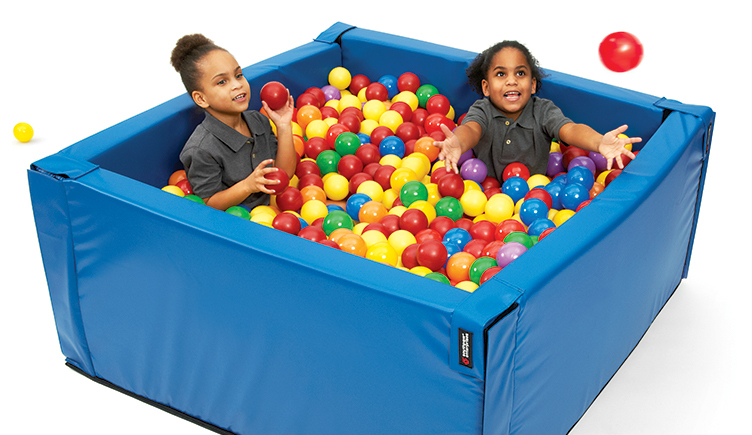SAFETY TIPS
Southpaw. Committed to Safety for Clients and Therapists.
Sensory integration therapy is not inherently dangerous, but every activity has certain elements of risk. Precautions can be taken that will eliminate most hazards.
Southpaw is committed to helping its customers develop a comprehensive safety strategy. We believe the elements of safety include the layout of the clinic or therapy space, the installation of ceiling eyebolt supports to the proper specification, the implementation of a systematic equipment inspection program, proper matting, and personal protection.
Call Southpaw’s knowledgeable Customer Service Representatives for more information on safety features at 800.228.1698.
CEILING SUPPORT
Ceiling support must be designed around the most rigorous environment, not necessarily the current one. Your ceiling support point should meet the following standards no matter what population you treat or the manner in which you treat them.
Your ceiling support point should be able to sustain at least a 1,000 pound load at up to a 45-degree angle in any direction. All eyebolts must be installed 6’ away from any wall or obstruction. Keep in mind that during treatment activities, the forces acting on the ceiling eyebolt will not always be straight down. Even a gentle swing on the equipment varies the angle of those forces on the ceiling support point. There should be no more than .25" of movement in your eyebolt, which is up to and inclusive of the stated 1,000-pound, 45-degree pull. Eyebolt movement beyond .25" or any rotation under any load is UNSAFE.
WARNING! Eyebolts will wear with use and must be inspected on a regular basis. Discontinue use of eyebolt and replace immediately when wear begins to show, never letting wear exceed 30%.
In ceiling support applications, following the inspection and maintenance checklist that comes with the product is even more critical where components of the ceiling support are above a dropped ceiling. In these situations, loose or worn components are typically only discovered by a scheduled inspection.
WORKING LOAD
The working load is the combined weight of the equipment, the child and/or therapist on it, and the weight created by movement. It is NOT the number at which the equipment will fail, but rather the maximum sustainable load that the equipment can handle.
To demonstrate, if a 150-pound person stands on a scale, it will read 150 pounds. However, if that person jumps on the scale, the reading will momentarily shoot way past 150 pounds. That is an example of weight created by movement, the result of which is the working load exerted on the scale.
MATTING
Because safety is always a priority, proper matting must be considered up front. Regardless of the application, we recommend as many of the best, thickest mats you can afford. When purchasing mats, consider these questions:
- What kind of suspended activities do your clients perform?
- Do activities include linear swinging, rotation or a mix?
- Do clients swing very high?
- Where do activities take place?
Once you have answered these questions, you will have a good idea of the floor space that will need to be covered with mats and how thick the mats should be.
DEVELOP A COMPREHENSIVE 3-STEP INSPECTION AND MAINTENANCE PROGRAM.
Most therapy equipment takes quite a beating. Southpaw works hard to design equipment around this fact by using the best materials available. However, even the best piece of equipment will have a finite life.
In the few instances of equipment failures we have seen over the years, most have been a result of parts wearing completely through, such as eyebolts breaking or ropes failing. The vast majority of failures can be completely prevented by simple, routine inspections and maintenance.
A Comprehensive 3-Step Inspection and Maintenance Program includes the following:
1. Training
All therapists who will use the equipment must familiarize themselves with the instruction sheet and maintenance checklist that comes with each item purchased from Southpaw. Both documents, which include a list of all parts, setup procedures (if applicable), safety notes, inspection point, and cleaning and storage instructions, need to be kept in a fully accessible, known location.
2. Know What Needs to be Inspected
As noted above, each item from Southpaw includes an instruction sheet and maintenance checklist. Each instruction sheet lists items to inspect on the product as well as inspection intervals. Following these guidelines will bring your attention to the wear on a piece of equipment before it becomes dangerous.
In addition to inspecting the specific points noted on the checklist, therapists must always inspect each piece of equipment as a whole before and after each use. The last person to use the equipment may have changed or reconfigured something that makes its use inappropriate for the next person.
3. Master Schedule
Developing a regular inspection and maintenance master schedule is one of the most significant steps you must take to keep equipment, therapists and clients safe.
A master schedule is highly detailed and includes a comprehensive list of all items requiring inspection, the related instruction sheets and checklists, and the dates on which each inspection should take place. The program should specifically identify assigned groups or persons to perform each task.
The importance of proper, scheduled maintenance cannot be overstated.



